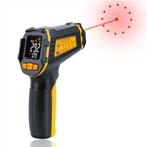How to fix the soldering iron without heating it up
There are two cases where the electric soldering iron does not heat up after being powered on. One is that it does not heat up at all after being powered on. This may be due to the damage of the soldering iron core or the power cord. At this time, you can use a digital multimeter to measure the resistance between the plugs of the power cord of the electric soldering iron. Generally, the resistance of a normal electric soldering iron is between one hundred and ten ohms to one or two thousand ohms (the greater the power of the electric soldering iron, the smaller the measured resistance). If the measured resistance is infinite, it may be that the soldering iron core or the power cord is damaged. Just replace the soldering iron core or power cord.
If the soldering iron is still slightly hot after being energized for a long time and cannot melt the solder wire, it may be that a thick oxide layer is attached to the inner wall of the soldering iron tip, which hinders the heat transfer from the soldering iron core to the soldering iron tip. Some cheap electric soldering irons do not have temperature adjustment and constant temperature functions, and use the copper soldering iron tip shown in the picture above, so that the copper soldering iron tip is easily oxidized at high temperature and produces a large thermal resistance. The oxide attached to the inner wall of the soldering iron tip causes the heat generated by the soldering iron core to not be transmitted to the soldering iron tip normally, thus failing to melt the solder wire.
If the soldering iron is still slightly hot after being energized for a long time and cannot melt the solder wire, it may be that a thick oxide layer is attached to the inner wall of the soldering iron tip, which hinders the heat transfer from the soldering iron core to the soldering iron tip. Some cheap electric soldering irons do not have temperature adjustment and constant temperature functions, and use the copper soldering iron tip shown in the picture above, so that the copper soldering iron tip is easily oxidized at high temperature and produces a large thermal resistance. The oxide attached to the inner wall of the soldering iron tip causes the heat generated by the soldering iron core to not be transmitted to the soldering iron tip normally, thus failing to melt the solder wire.
If the soldering iron head is seriously oxidized and cannot solder normally, it is recommended to replace it with a better temperature-adjustable soldering iron. After all, the quality of the soldering iron has a great influence on the soldering quality. The temperature-adjustable electric soldering iron shown in the picture above costs only more than 20 yuan. It has a built-in temperature-regulating circuit, and the soldering iron tip is made of alloy, which is not easy to oxidize and blacken at high temperatures, so it is very convenient to use.
The electric soldering iron is composed of several parts such as a soldering iron tip, a soldering iron core, a metal casing, a wood (plastic) handle, a terminal post, and a power cord. The heat source of the soldering iron is the soldering iron core installed on the head, as long as the soldering iron core is powered on, it can work normally.
If the soldering iron is not hot, first use a multimeter to measure the two pins of the power plug. Under normal circumstances, the resistance should be between several hundred to several thousand ohms. If it is in an open circuit state, you need to open the handle to check whether the wiring is firm and reliable. Then measure the terminal,
The connection between the terminal post and the lead wire of the soldering iron core is a place that is prone to problems. Sometimes it seems that the connection is good but it has been disconnected. Careful inspection is required. If the soldering iron core is damaged, just buy a new one and replace it.






